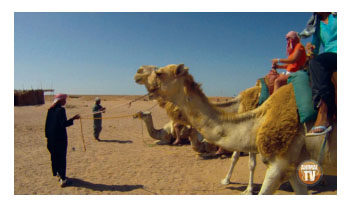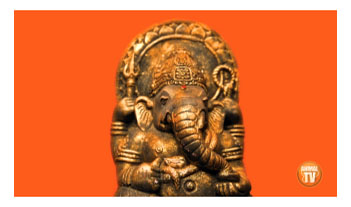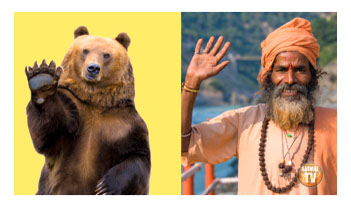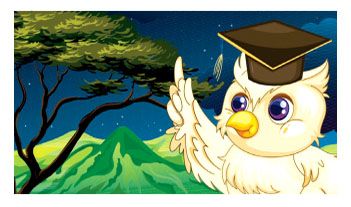WATCH AND LISTEN
A. Choose the statement that best summarizes the main idea presented at these points in the video.

1 a When we have wanted animal companions, we have domesticated them.
b Wherever humans have wanted to go, animals have provided transportation.
c When we need help pulling things, animals are there.

2 a When the earliest humans depicted their gods, it was usually an animal or part human and part animal.
b Whenever early humans depicted animals, they were really depicting humans.
c The earliest humans saw their gods when they looked to the skies.

3 a Thousands of years ago, when humans described animals, they compared them to people.
b When different cultures describe humans, they usually compare humans to bears.
c Different cultures may use different descriptions, but we all compare humans to animals.

4 a When we look at owls, we compare them to humans, too.
b When we tell stories, we often attribute human qualities to animals.
c Animal-like humans are common in entertainment media.
B. Choose the correct answers according to the information in the video.
1 Through domestication, transportation, and survival,
a humans have depicted animals as useful
b animals have become dependent on humans
c humans and animals have become strongly linked
2 The tradition of depicting gods as animals shows
a that people saw gods all around them
b that all cultures are the same
c man’s deep connection to animals
3 Early humans thought they saw
a humans in animals
b animals in humans
c gods in some people
4 We use many phrases that
a contrast human arid animal behavior
b make fun of people by comparing them to animals
c use animals to describe the essence of a person
5 Cartoons and movies often show
a animal attributes in humans
b interesting animal behavior
c animals with human qualities
C. Match the animals with their associated human traits.
1 snake ____
2 lion ____
3 peacock ____
4 chicken ____
5 owl ____
6 bee ____
7 lamb ____
8 fox ____
9 gorilla ____
10 horse ____
11 kitten ____
12 snail ____
a vain
b wise
c slow
d sly
e playful
f courageous
g scared
h hungry
i hairy
j evil
k busy
l gentle
Answers
A
1 b 2 a 3 c 4 b
B
1 c 2 c 3 b 4 c 5 c
C
1 j 2 f 3 a 4 g 5 b 6 k
7 l 8 d 9 i 10 h 11 e 12 c
Audioscripts
Narrator: Since the beginning of civilization, wherever you found humans, you’d find animals, as well. We are inextricably linked to animals. When we have wanted companions, we have domesticated animals like dogs and cats. When we have needed transportation, horses and donkeys, elephants and camels, and even dogs have taken us wherever we wanted to go. When we have needed help in the fields, our cattle and oxen have pulled whatever we needed them to pull. To help us survive, animals have given us milk, eggs, and meat when we needed them.
Whatever it is that draws us to animals, the connection is a deep one. Whenever the earliest humans depicted their gods, it was usually as an animal or a creature part human, part animal. They saw animals when they looked to the skies, where they believed their gods lived. And they saw animals when they looked at other human beings.
Today, thousands of years later, whenever we want to describe the essence of a person, we usually compare them to animals. The descriptions may change from culture to culture, but in English, when we think of an evil person, we think of a snake. Whoever is courageous gets named a lion. A vain person may be called a peacock, and a scared person we liken to a chicken.
Over the years, we’ve developed quite a lot of ways to describe people using animals. We talk about people who are as wise as an owl. An industrious person is as busy as a bee. Whoever is kind is referred to as gentle as a lamb. When someone looks suspicious, we may say that they’re as sly as a fox. Blind as a bat is what we say about whoever has terrible eyesight. We know people who are hairy as a gorilla or as hungry as a horse. Whenever we meet a really fun-loving child, we call them playful as a kitten. When we’re frustrated with the pace someone is moving at, we’ll call them as slow as a snail.
And while we frequently see animal behavior in our fellow human beings, we see human behavior in animals almost constantly. Since the time of Aesop’s fables in the sixth century BCE, we have been telling stories that attribute human qualities to animals.
Today, humanlike animals fill our storybooks, our cartoons, our movies, and our stores. Whatever would we do without the animal world?
